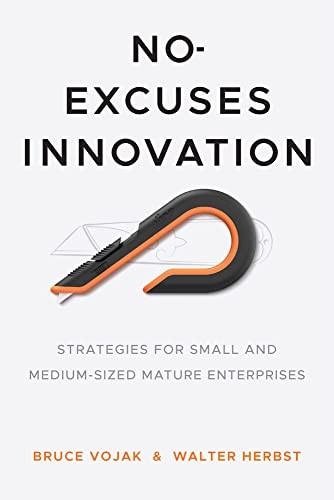Explore the World's Best Ideas
Join today and uncover 100+ curated journeys from 50+ topics. Unlock access to our mobile app with extensive features.
No-Excuses Innovation
- Innovation seems too expensive until someone else has a breakthrough.
- Design thinking gives you a reliable, low-cost and low-risk way to start innovating.
- Innovate by tapping into your customers’ emotions.
- Use innovation tools to keep innovation moving from idea to market.
- The “who” of innovation is as important as the “how.”
- Encourage communication and alignment across your organization with strategic planning.
122
2.21K reads
Innovation seems too expensive until someone else has a breakthrough
“At the extreme, renewal by way of breakthrough innovation redefines the nature of competition.”
“Innovation is all about increasing the net present value of your business. If you are serious about financial and operational sustainability, the argument that it reduces profits does not hold.”
116
1.49K reads
Successful small and medium-sized mature enterprises combine four qualities:
- Optimization of your production processes using tools like lean six sigma.
- Incremental innovations, such as improvements to your existing product line or expansion to new markets.
- Innovations related to product platforms, such as the development of a base product that has qualities that make its market share defendable and that you can use to develop spin-offs that drive conversions.
- Breakthrough innovations that change the paradigm and shift the basis of competition.
122
1.21K reads
Design thinking gives you a reliable, low-cost and low-risk way to start innovating
Design thinking involves a series of concrete activities:
- Come up with as many ideas and potential solutions as possible – Aim for volume.
- Use empathy to understand the user’s point of view – To come up with the most relevant ideas, do a deep dive into the user’s experience and emotions.
- Embrace creative risk-taking – In order to get to a breakthrough, you have to be open to making mistakes.
- Iterate through rapid prototyping and testing – The best way to manage risk is to do multiple low-cost tests with real users.
122
970 reads
Innovate by tapping into your customers’ emotions
“Design is a way to build an experience around the user.”
While it is common to focus on customers’ needs, if you want them to want your product, you have to appeal to their emotions. Products with good emotional design are understandable and easy to use. They answer the customer’s most pressing questions: what, why, where, when, who and how. If you are not appealing to your customers’ emotions, you are left competing strictly on price, forcing you and your competitors to accept narrower and narrower margins.
124
827 reads
Use innovation tools to keep innovation moving from idea to market
- The “phase-gate” process divides idea development activities into phases – Each “phase” represents an incrementally larger investment, separated by “gates” where you make a formal decision about whether to continue
- “Lean innovation” reduces wasted resources by testing the “minimum viable product” – Find the simplest, fastest, cheapest version of a product concept that you can test with lead customers and then do so on a small scale
- “Open innovation” lets you outsource certain aspects of innovation
- “Product and technology road maps” help you communicate your innovation options to your customers
119
763 reads
The “who” of innovation is as important as the “how.”
To do this, make sure you identify, develop and work with the serial innovators in your business:
- Serial innovators engage with problems with curiosity and possess a drive to understand the problem deeply and look beyond the first or most obvious solution
- They work tenaciously on projects and delve deeply into the customer’s point of view and needs
- They keep in mind that they need to bring ideas to market.
- They see the value in other people and enlist their strengths in the pursuit of their goals
- They work non-linearly: Innovators are always ready to backtrack and reconsider earlier steps
115
674 reads
Encourage communication and alignment across your organization with strategic planning
Your strategy connects your vision to your day-to-day activities. There are, broadly, two types of strategies:
“Market share” strategies increase economies of scale by growing your share of the market. You can do this by differentiating your product, lowering its cost or entering a new, unoccupied niche.
“Synergy” strategies increase economies of scope by expanding into different products or markets with activities that can share resources or expertise.
110
663 reads
Organizational Alignment
Objective-based planning is a strategic planning method that lets you model the relationship of every level of your organization to your organization’s objectives:
- Objectives define the overarching direction of your organization.
- Goals are “stepping stones” towards your objective.
- Strategies are what you choose to focus on to achieve your goals.
- Measures are the quantitative benchmarks that allow you to determine the effectiveness of your strategies.
- Tactics are the fine-grained, short-term actions you take as part of your strategies.
124
629 reads
IDEAS CURATED BY
CURATOR'S NOTE
Strategies for Small and Medium-Sized Mature Enterprises
“
instructor Hood's ideas are part of this journey:
Learn more about strategy with this collection
How to set clear objectives
How to follow up after a meeting
How to manage time effectively
Related collections
Discover Key Ideas from Books on Similar Topics
10 ideas
HBR's 10 Must Reads on Strategy
Harvard Business Review, Michael E. Porter
6 ideas
Good to Great
Jim Collins
10 ideas
Blue Ocean Strategy, Expanded Edition
Renee Mauborgne, W. Chan Kim
Read & Learn
20x Faster
without
deepstash
with
deepstash
with
deepstash
Personalized microlearning
—
100+ Learning Journeys
—
Access to 200,000+ ideas
—
Access to the mobile app
—
Unlimited idea saving
—
—
Unlimited history
—
—
Unlimited listening to ideas
—
—
Downloading & offline access
—
—
Supercharge your mind with one idea per day
Enter your email and spend 1 minute every day to learn something new.
I agree to receive email updates

